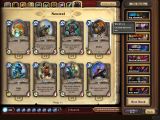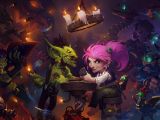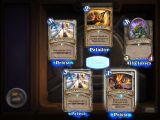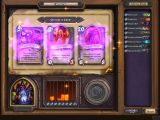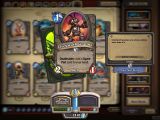Next up in our Softpedia Game of the Year 2014 awards is the best game of the entire year, Blizzard Entertainment's Hearthstone.
Many solid games came out this year, but Hearthstone had, by far, the most impact on me. Blizzard's collectible card game is the sole title that I still routinely play. All the others I have put down. But not it.
The game is objectively good for several reasons. First of all, it's a free-to-play game that's perfectly balanced. Sure, if you shell out cash, you get a solid card collection faster and your chances to win increase, but you will never have any advantage over a non-paying player.
The grind is tedious, but it's entirely possible to play Hearthstone competitively without paying anything. It's hard and requires dedication and focus, which is another discussion entirely, but there have been numerous examples of people reaching Legend rank with free accounts.
Objective reasons
Blizzard was nimble and had the right vision for the game, making Hearthstone a success story even before the masses could get their hands on it. And who doesn't like a success story from something that looks like an underdog, a geeky collectible card game?
The game managed to rise to Internet fame due to its brilliant design, being a great thing to watch, and many online broadcasters took to Twitch and other streaming outlets to show their games and provide useful commentary on their decisions, being watched by millions of gamers all around the world.
Hearthstone itself managed to get over 20 million gamers to register for an account and try the game, a huge feat for its first year of existence.
The game has just the right balance of difficulty, strategy and luck to get people interested in it. Just like some boardgame enthusiasts despise eurogames, other hate dice and all the randomness they entail, and Hearthstone seems to have both working in tandem, providing a satisfying experience.
Assembling a deck of 30 cards out of your collection is also an important aspect of the game, giving tinkers something to do, trying to discover new ways for the cards to interact with one another and new silver bullets to take down the heavy hitters of ranked play.
The game is also dynamic and interactive enough not to bore people, but the level of complexity is curtailed by the fact that you can't interact with the game on your opponent's turn, in order to keep things manageable for newcomers and for those who don't like unnecessary complexity.
The game is mainly about board control, which means that it's easy to understand and that combos are limited in scope, and you won't have to wait for your opponent to figure out whether he would be able to fire off a ten-card combination this turn or not, and won't have to worry about losing the game instantly.
It's a brilliant design where incremental advantage is won with every turn, and good decisions (coupled with a bit of luck) are rewarded and can even turn the outcome of a game around.
The match length is also one of Hearhstone's strong points, with bouts taking around three to ten minutes each, as opposed to the more demanding card games' marathon run-ins that can easily stretch to forty or more minutes.
Another advantage Hearthstone has over fresh IPs is the twenty years of Warcraft lore to bank on, as the game presents a ton of familiar characters, from shady lowbies like Defias Bandits and Silver Hand Recruits to legendary ones such as Cairne Bloodhoof or Grommash Hellscream.
The character classes are instantly recognizable for any World of Warcraft player and their abilities, spells and minions tie in with the lore and each class' specific mechanics and play style.
Furthermore, Blizzard has already released two new pieces of content, a single-player one, Curse of Naxxramas: A Hearthstone Adventure, and a full-fledged expansion, Goblins vs Gnomes.
Subjective reasons
I have already paid more than an AAA game's worth to Blizzard, in part to speed up the process of accumulating cards, but most importantly, because the game is worth it.
Free-to-play games usually have a way of coercing you or inconveniencing you to the point of frustration, but thankfully, Hearthstone is balanced so that your skill can ensure your progress.
Earlier this year, I used to play arenas, and I always managed to come on top. You get random cards, so large collections are no longer a factor. If you play tight, you can always win enough games to make it a better choice than simply buying packs with your gold.
Now I just don't want to dedicate as much time to it. I play exclusively on the ranked ladder, and going below rank 10 is increasingly difficult without all the right cards and a finely tuned deck. Thankfully, my time versus real money calculation worked out, so I have several good decks as well as something to still look forward to, as I am yet to reach Legend.
That is a definite win in my book. I'm not a fan of serialized franchises such as FIFA or Call of Duty. I enjoyed Fallout 3, Skyrim and World of Warcraft too much to be easily sold on the idea of 10 hours of fun from a full-price game, and Hearthstone provides enough variety and enough challenges to sate my need for multiplayer interaction far beyond what Call of Duty deathmatches can do.
What this essentially means is that Blizzard managed to create a serialized franchise that I will be buying into each year, and doing so gladly, which is something that I couldn't believe to be possible until now.
And the fact that the game is now out on Android, making it easy to just grab your phone and get into a quick match or two while in transit or waiting, makes it even more accessible and appealing.
If you want to learn more, you can read our review of Hearthstone: Goblins vs Gnomes.
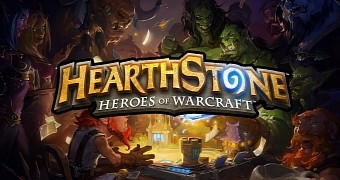
 14 DAY TRIAL //
14 DAY TRIAL // 
